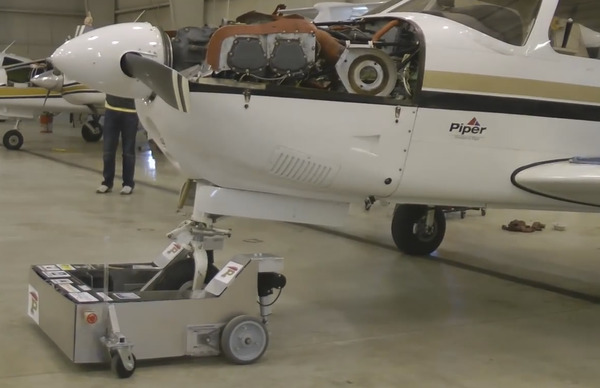Pololu Blog »
The Purdue Tuggiteers' spring 2015 senior design project
For their senior design project in the spring semester of this year, a team of Mechanical Engineering students (the Tuggiteers!) from Purdue made a remotely-controlled plane-towing vehicle that uses one of our step-up/step-down regulators. The team shared with us this video of their final review, which demonstrates the vehicle approaching, connecting to, and towing a single-engine aircraft:
This next video captures their vehicle’s first test. An on-board camera allows you to get a 1st-person view of the latch actuating and gripping the aircraft wheel:
We are always excited to see our parts getting used in cool projects, and we were especially excited to see this because it looks way easier than doing it the usual way:
 |
Ben, pushing a plane (before he started Crossfit). |
|---|
4 comments
We did not design the tug, so while we do know a few pieces of information about what went into the design for this project, we think it is more appropriate that the students get a chance to respond to your questions. We let them know you commented.
-Jon
We left most of the design information with our professor when we graduated in the spring, but I do know that we used 2 LD linear actuators from Pololu for the lifting arm (part number 2314).
-Natalie
We used a Arduino Uno combined with a 6 channel Turnigy RC remote for our robot. We used custom logic to control all of the actuators to make it safer, and wrote some basic code to use a single joystick to drive the robot. We had four 12V motorcycle batteries hooked up in parallel to provide an estimated 50-minute aircraft pull time. It used two 400-lb linear actuators to lift the nose wheel and a smaller linear actuator to capture the wheel before lifting. We used CIM motors combined with some huge sprockets to provide a very low final drive ratio. The max speed was about 2.5 mph. The Pololu S18V20F6 regulator was used to convert the (highly variable under-load) 12V from the batteries into a reliable 6V for our sensitive low-voltage electronics like the Arduino.
The total cost to our team was about $1500, but we did receive significant part donations from a variety of manufacturers. However, this was a prototype, and we would expect a final product to be much more refined and have a significantly lower cost.
Thanks,
Grant






